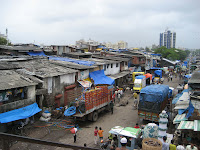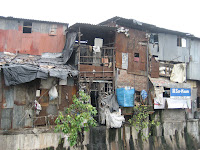SHANTITOWN
MULTIFUNCTION BUILDING SYSTEM IN BAMBOO FOR EMERGENCY APPLIED TO THE CASE OF SHANTYTOWNS IN MUMBAI (INDIA) -by Claudia Marforio-

The very first idea for my work came to my mind while I was coming back home from my second travel in India. I was in a cab in Mumbai, going to the airport, and from my window I was looking at the very poor houses along the road, wandering about some little and cheap changes that could improve their conditions.
I didn’t know yet, but I was crossing Dharavi, the biggest slum of Asia, the second one in the world (as somebody says, but it’s difficult to give numbers in these cases). Dharavi is an incredible working reality, always moving and growing. More than 1 million people lives there, in a slum too near to the centre of Mumbai to be ignored by economical interests.
I came back to Dharavi after 2 years - in 2008 - and I lived in Mumbai for 3 weeks studying the reality of Indian slums, the bamboo scaffoldings system and trying to do my best for my thesis to be as real as possible (I studied Building Engineering and Architecture at the Politecnico di Milano).
“SHANTITOWN” is a play on the words “shantytown” (meaning slum) and “shanti” (sanskrit word for peace).
The idea is to create a multifunction building system for emergency applied to the case of shantytowns. The frame is made with bamboo simply tied, as the techniques of Asian scaffoldings. The claddings are made with different recycled materials, as typical in cases of necessity.
All the material and the techniques are local, nothing needs to be imported, and local Indian workers can teach people to create their home and to maintain it.
I followed the principles of slum (recycled and cheap material, simple systems, teaching of techniques, multifunctional buildings..) trying to obtain the best comfort possible.
Sunday 10 February, 2013
Scaffolding in Mumbai
Friday 8 February, 2013
Structural Analysis
Wednesday 31 October, 2012
Tuesday 30 October, 2012
Tuesday 15 February, 2011
A view on Dharavi: Koliwada
This district is very famous for the gold worked in Tamil style.
A view on Dharavi: Transit Camp
It is an interesting district to study the abitative solutions that the government gave to people.
A view on Dharavi: 13 Compound
The main activity is recycling, mainly of plastic. It is the biggest industry of this kind in all India with more than 5.000 workers, payed about 40 Rupies a day for 11 working hours. This activity brings millions of Rupies to Mumbai.





















































